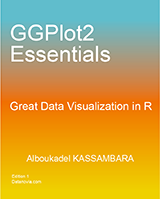This R tutorial describes how to create a density plot using R software and ggplot2 package.
The function geom_density() is used. You can also add a line for the mean using the function geom_vline.

Related Book:

GGPlot2 Essentials for Great Data Visualization in R
Prepare the data
This data will be used for the examples below :
set.seed(1234)
df <- data.frame(
sex=factor(rep(c("F", "M"), each=200)),
weight=round(c(rnorm(200, mean=55, sd=5),
rnorm(200, mean=65, sd=5)))
)
head(df)## sex weight
## 1 F 49
## 2 F 56
## 3 F 60
## 4 F 43
## 5 F 57
## 6 F 58Basic density plots
library(ggplot2)
# Basic density
p <- ggplot(df, aes(x=weight)) +
geom_density()
p
# Add mean line
p+ geom_vline(aes(xintercept=mean(weight)),
color="blue", linetype="dashed", size=1)

Change density plot line types and colors
# Change line color and fill color
ggplot(df, aes(x=weight))+
geom_density(color="darkblue", fill="lightblue")
# Change line type
ggplot(df, aes(x=weight))+
geom_density(linetype="dashed")

Read more on ggplot2 line types : ggplot2 line types
Change density plot colors by groups
Calculate the mean of each group :
library(plyr)
mu <- ddply(df, "sex", summarise, grp.mean=mean(weight))
head(mu)## sex grp.mean
## 1 F 54.70
## 2 M 65.36Change line colors
Density plot line colors can be automatically controlled by the levels of sex :
# Change density plot line colors by groups
ggplot(df, aes(x=weight, color=sex)) +
geom_density()
# Add mean lines
p<-ggplot(df, aes(x=weight, color=sex)) +
geom_density()+
geom_vline(data=mu, aes(xintercept=grp.mean, color=sex),
linetype="dashed")
p

It is also possible to change manually density plot line colors using the functions :
- scale_color_manual() : to use custom colors
- scale_color_brewer() : to use color palettes from RColorBrewer package
- scale_color_grey() : to use grey color palettes
# Use custom color palettes
p+scale_color_manual(values=c("#999999", "#E69F00", "#56B4E9"))
# Use brewer color palettes
p+scale_color_brewer(palette="Dark2")
# Use grey scale
p + scale_color_grey() + theme_classic()


Read more on ggplot2 colors here : ggplot2 colors
Change fill colors
Density plot fill colors can be automatically controlled by the levels of sex :
# Change density plot fill colors by groups
ggplot(df, aes(x=weight, fill=sex)) +
geom_density()
# Use semi-transparent fill
p<-ggplot(df, aes(x=weight, fill=sex)) +
geom_density(alpha=0.4)
p
# Add mean lines
p+geom_vline(data=mu, aes(xintercept=grp.mean, color=sex),
linetype="dashed")


It is also possible to change manually density plot fill colors using the functions :
- scale_fill_manual() : to use custom colors
- scale_fill_brewer() : to use color palettes from RColorBrewer package
- scale_fill_grey() : to use grey color palettes
# Use custom color palettes
p+scale_fill_manual(values=c("#999999", "#E69F00", "#56B4E9"))
# use brewer color palettes
p+scale_fill_brewer(palette="Dark2")
# Use grey scale
p + scale_fill_grey() + theme_classic()


Read more on ggplot2 colors here : ggplot2 colors
Change the legend position
p + theme(legend.position="top")
p + theme(legend.position="bottom")
p + theme(legend.position="none") # Remove legend


The allowed values for the arguments legend.position are : “left”,“top”, “right”, “bottom”.
Read more on ggplot legends : ggplot2 legends
Combine histogram and density plots
- The histogram is plotted with density instead of count values on y-axis
- Overlay with transparent density plot
# Histogram with density plot
ggplot(df, aes(x=weight)) +
geom_histogram(aes(y=..density..), colour="black", fill="white")+
geom_density(alpha=.2, fill="#FF6666")
# Color by groups
ggplot(df, aes(x=weight, color=sex, fill=sex)) +
geom_histogram(aes(y=..density..), alpha=0.5,
position="identity")+
geom_density(alpha=.2) 

Use facets
Split the plot in multiple panels :
p<-ggplot(df, aes(x=weight))+
geom_density()+facet_grid(sex ~ .)
p
# Add mean lines
p+geom_vline(data=mu, aes(xintercept=grp.mean, color="red"),
linetype="dashed")

Read more on facets : ggplot2 facets
Customized density plots
# Basic density
ggplot(df, aes(x=weight, fill=sex)) +
geom_density(fill="gray")+
geom_vline(aes(xintercept=mean(weight)), color="blue",
linetype="dashed")+
labs(title="Weight density curve",x="Weight(kg)", y = "Density")+
theme_classic()
# Change line colors by groups
p<- ggplot(df, aes(x=weight, color=sex)) +
geom_density()+
geom_vline(data=mu, aes(xintercept=grp.mean, color=sex),
linetype="dashed")+
labs(title="Weight density curve",x="Weight(kg)", y = "Density")
p + scale_color_manual(values=c("#999999", "#E69F00", "#56B4E9"))+
theme_classic()

Change line colors manually :
# Continuous colors
p + scale_color_brewer(palette="Paired") + theme_classic()
# Discrete colors
p + scale_color_brewer(palette="Dark2") + theme_minimal()
# Gradient colors
p + scale_color_brewer(palette="Accent") + theme_minimal()


Read more on ggplot2 colors here : ggplot2 colors
Infos
This analysis has been performed using R software (ver. 3.1.2) and ggplot2 (ver. 1.0.0)